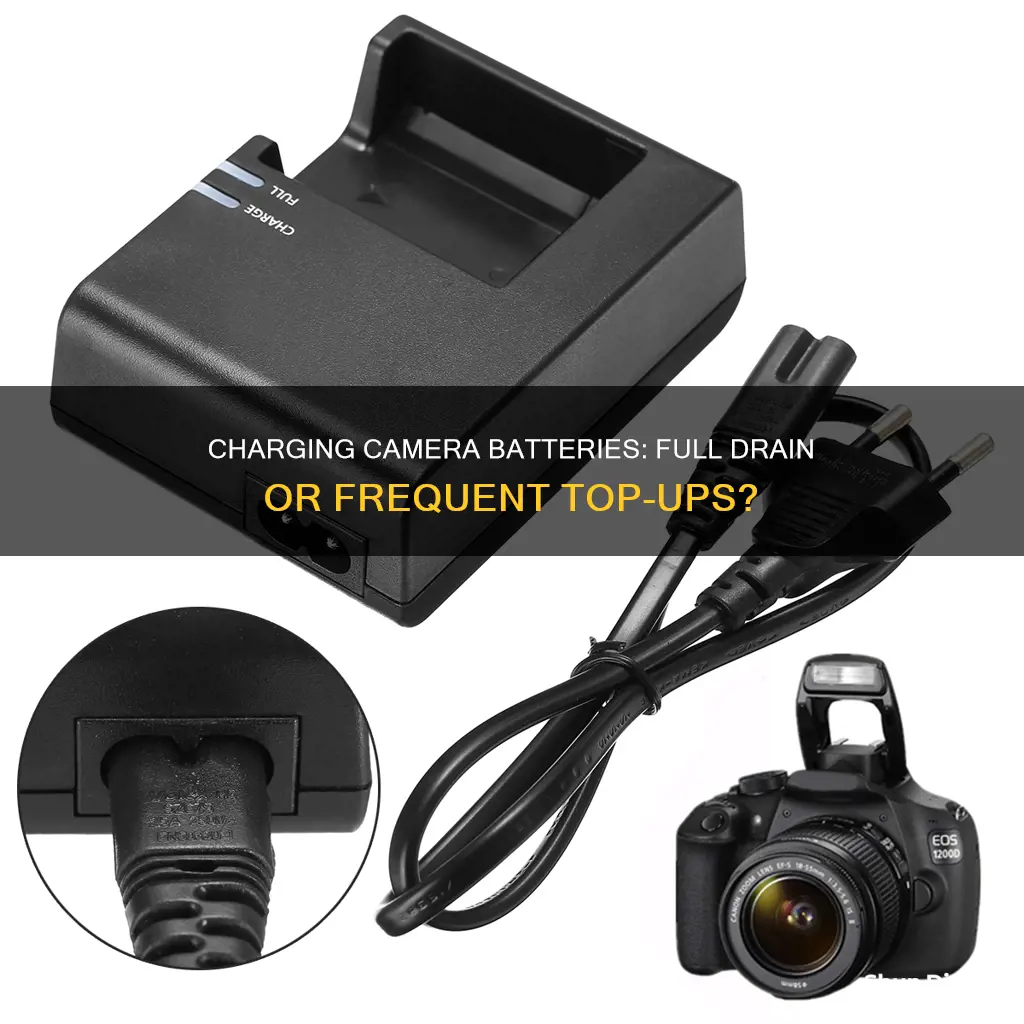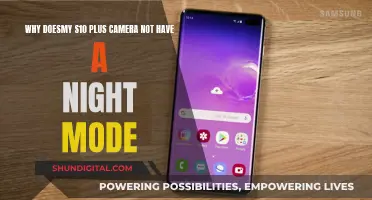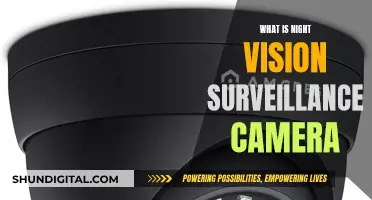
Should you let your camera battery die before charging it? This is a common question, and there are some misconceptions surrounding battery technology. The answer depends on the type of battery and its specific memory effect. Modern lithium-ion batteries, which are commonly used in cameras, do not require complete discharge before recharging. In fact, it is recommended to recharge your camera battery when it reaches around 20-30% capacity, as this will help prolong the battery's lifespan.
What You'll Learn
- Lithium-ion batteries are commonly used in cameras
- It is recommended to charge your camera battery before it runs out of power
- Each time you fully discharge a lithium-ion battery, you use up one of its limited charge cycles
- It is recommended to recharge your camera battery when it reaches 20-30% capacity
- Optimal charging practices for camera batteries have evolved over the years

Lithium-ion batteries are commonly used in cameras
Lithium-ion batteries have a high energy density, which means they can store a large amount of power in a compact volume. This is particularly advantageous for camera designers as it allows them to create smaller and lighter cameras. The lightweight design of lithium-ion batteries also enhances their portability and user-friendliness.
Another advantage of lithium-ion batteries is their low self-discharge rate. This means they can retain their charge for longer periods when not in use, making them ideal for photographers who may not use their cameras frequently but still want the battery to be ready when needed. Additionally, lithium-ion batteries have a long battery life and can hold a charge longer than other battery types. This is especially beneficial for photographers who work on-site or in isolated areas with limited access to power sources.
Lithium-ion batteries are also fast-charging, thanks to technological advancements. This allows photographers to capture moments more efficiently and spend less time waiting for their batteries to charge. The quick charging time is especially useful for professionals with busy schedules who need their equipment to be ready at all times.
While lithium-ion batteries offer numerous benefits, there are also some drawbacks to consider. One of the main disadvantages is their comparatively higher price. The cost of raw materials and refining processes is higher for lithium-ion batteries due to the use of rare metals. As a result, their prices can differ between brands and be relatively expensive.
Another concern with lithium-ion batteries is safety. It is important to use caution when using them in extreme temperatures or high-pressure situations. While premium batteries with UL Certification can help reduce this risk, it is still something to be aware of. Additionally, lithium-ion batteries can be challenging to repair and maintain due to their sophisticated technology and strict international safety regulations.
In summary, lithium-ion batteries are commonly used in cameras due to their high energy density, extended longevity, lightweight construction, and low self-discharge rate. However, they may be more expensive and require careful handling to ensure safety and proper maintenance.
Charging the Eyoyo Underwater Camera: A Step-by-Step Guide
You may want to see also

It is recommended to charge your camera battery before it runs out of power
Lithium-ion batteries have a limited number of charge cycles, and each time you fully discharge the battery, you are using up one of those cycles. Additionally, fully discharging the battery can cause it to lose its ability to hold a charge over time. Therefore, it is generally recommended that you recharge your camera battery when it reaches around 20-30% capacity. This will help to prolong the battery's lifespan and ensure that you always have enough power to capture the shots you need.
It is worth noting that some camera manufacturers may have specific recommendations for charging their batteries, so it is always a good idea to consult your camera's manual for guidance. Properly charging and storing your battery is important to ensure its longevity and safety. For example, lithium-ion batteries should be stored in a cool, dry place and should not be left in extreme temperatures or direct sunlight.
In summary, it is not necessary to let your camera battery die before charging it. By charging your battery before it completely dies, you can prolong its lifespan and ensure that it is ready for your next shoot.
Charging the Canon Powershot A620: A Quick Guide
You may want to see also

Each time you fully discharge a lithium-ion battery, you use up one of its limited charge cycles
Lithium-ion batteries are extensively used in solar power kits. They make excellent batteries for solar panels, portable solar generators, and electric cars. You may also use them to power your tools when undertaking solar power maintenance. Lithium-ion batteries are low-maintenance, extremely efficient, and long-lasting.
Lithium-ion batteries may be used with a variety of solar systems. An on-grid solar system may be made more powerful by adding battery storage. On the other hand, solar batteries can provide you with more flexibility, capacity, and tranquillity if you live off the grid. We will now go through the charging cycles of lithium-ion polymer batteries in-depth to ensure optimal use.
A charging cycle is a full charge and discharge of a rechargeable battery. When you drain a battery when powering a gadget, you discharge it since the battery was charged before usage or purchase. The standard technique for measuring rechargeable battery charge cycles is the number of charge cycles that a battery can tolerate before performance decreases.
Lithium batteries, often known as Lithium-ion Polymer (LiPo) batteries, are non-aqueous electrolyte batteries that employ Lithium as the negative electrode. Lithium-ion Polymer batteries have quickly become the primary power supply for a wide range of applications and sectors, thanks to continued improvement.
Lithium batteries benefit more from shallow discharge and shallow charging. Deep lithium batteries charging is only required when the device's power module is calibrated for lithium-ion batteries. As a result, lithium-ion-powered gadgets are not restricted by the process: they may be charged at any time without compromising battery life.
Shallow cycle charging is designed to enable batteries to provide short bursts of energy and not be used for an extended period before being fully charged. Deep cycle ensures your battery can manage long-term use by reaching much below 50% discharge before needing to be recharged.
It's crucial to remember that Shallow Cycle batteries abhor being depleted over lengthy periods. If you want to care for your shallow cycle battery (and hence extend its life), install a discharge control circuit that will turn off the battery when drained to around 50% and replenish it as soon as possible. If it isn't clear, having a smart charge/discharge monitor is critical for maintaining the health of your deep cycle or shallow cycle battery.
A Lithium battery has a lifespan of 300 to 500 charging cycles. Assume that a full discharge can give Q capacity. Lithium batteries can deliver or supplement 300Q-500Q power in total over their lifetime if the capacity decline after every charging cycle is not taken into account. We can charge 600-1000 times if we use half of the capacity each time and 2400-4000 times if we use 1/8 each time.
Consequently, if you charge at random, the number of times you charge is unpredictable. In essence, no matter how a Lithium battery is charged, a total of 300Q to 500Q of power is always added. Consequently, we may conclude that the life of a Lithium battery is proportional to the battery's overall charge, not to the number of charges. Deep charge and shallow charging have similar impacts on lithium battery life.
Japan Camera Import: Customs and Charging
You may want to see also

It is recommended to recharge your camera battery when it reaches 20-30% capacity
Lithium-ion batteries function best when kept between a 20-80% charge. Therefore, it is beneficial to charge your camera battery when it reaches 20-30% capacity to maintain optimal battery health and ensure you have enough power for your device. By doing so, you can prolong the battery's lifespan and reduce the risk of accelerated degradation.
Additionally, modern camera batteries are designed to be charged and discharged frequently, and they have built-in protection circuits that prevent overcharging and overheating. This means there is no harm in charging your camera battery before it completely dies. In fact, it is generally recommended that you avoid letting your camera battery die completely before recharging it.
It is worth noting that some camera manufacturers may have specific recommendations for charging their batteries, so it is always advisable to consult your camera's manual for guidance. Proper battery maintenance, such as storing your battery in a cool, dry place and using the correct charger, can also help prolong its lifespan.
In summary, to ensure optimal performance and longevity of your camera battery, it is recommended to recharge it when it reaches 20-30% capacity. This practice will help preserve the battery's lifespan and ensure your camera is always ready to capture the moments that matter.
Alternative Charging Methods for Your Zimodo Camera
You may want to see also

Optimal charging practices for camera batteries have evolved over the years
Lithium-ion batteries, which are commonly used in modern cameras, do not suffer from the "memory effect" that older nickel-cadmium batteries exhibited. This means that they do not need to be fully discharged before being recharged. Instead, lithium-ion batteries perform best when kept between a 20-80% charge range, and each deep discharge can harm the battery over time.
To ensure the longevity of your camera's lithium-ion battery, it is recommended to recharge it when it reaches around 20-30% capacity. This will help to prolong the battery's lifespan and ensure that you always have enough power for your photography needs. Additionally, it is important to use the charger that is specifically designed for your camera battery to avoid any potential damage.
Proper storage of camera batteries is also crucial. Lithium-ion batteries should be stored in a cool, dry place, away from extreme temperatures and direct sunlight. If you plan on not using your camera for an extended period, it is recommended to store the battery with around a 50% charge to maintain its lifespan.
In summary, optimal charging practices for camera batteries involve recharging them before they completely die, using the correct charger, and storing them properly when not in use. By following these practices, photographers can ensure their camera batteries remain in good condition and last as long as possible.
Charging Your Roku Doorbell Camera: A Step-by-Step Guide
You may want to see also
Frequently asked questions
No, it is not recommended to let your camera battery die before recharging it. This is because lithium-ion batteries, which are commonly used in cameras, do not have a "memory effect" and can be recharged at any time.
Yes, allowing your camera battery to die completely can be detrimental to the battery's lifespan. Each time you let your battery die, it uses up one of its limited charge cycles and can cause it to lose its ability to hold a charge over time.
It is recommended to recharge your camera battery when it reaches around 20-30% capacity. This will help prolong the battery's lifespan and ensure you always have enough power.
Optimal charging practices include charging your battery as soon as possible after use, using the correct charger, and storing it properly when not in use. Modern camera batteries are designed to be charged and discharged frequently without affecting their lifespan.
The "memory effect" is a phenomenon that occurs in older nickel-cadmium batteries, where the battery "remembers" the amount of charge it previously received and would only charge up to that level. This is not an issue with modern lithium-ion batteries, so there is no need to fully discharge them before recharging.







